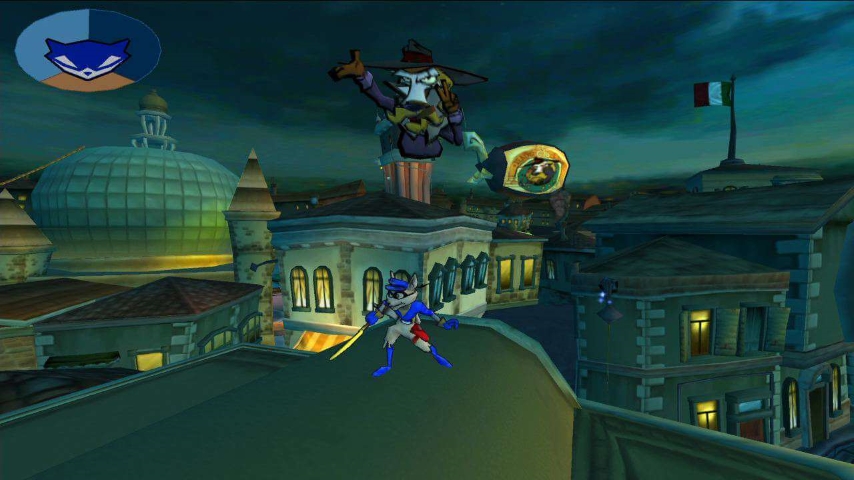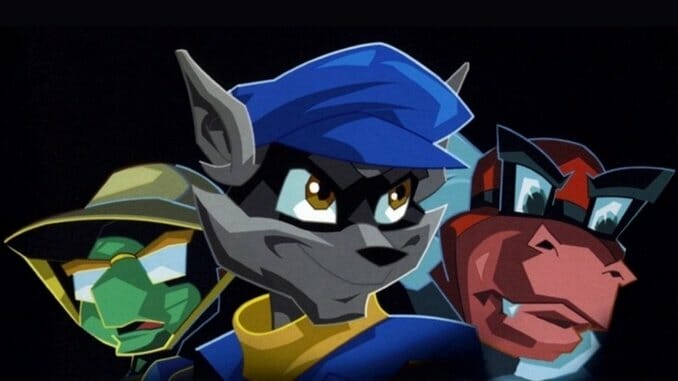The tale of Sly Cooper and the Thievius Raccoonus waits for no one to begin. Before so much as a start menu appears, we see the titular roguish raccoon, traipsing along the moonlit rooftops of cartoon-noir Paris. He stands idly beside the neon glow of ‘le police’ headquarters as he awaits your command, cool, collected, and braced to lift his binoculars up to his twice-masked eyes and devise a plan. There’s no great exposition prior to your infiltration of police headquarters—no tale of an almighty, escaped evil, a world turned black, or a loved one lost. Instead, Sly’s confidence is bestowed upon the player, and before you even understand why you’re scaling ledges, crawling through air ducts, and finessing your way through laser beams in search of a single file, you’re doing it. Everytime our thieves’ feet hit the ground, they do so running, and we quickly learn ours should too—and at nine years old, it was the coolest I had ever felt beginning a game.
By the time I was nine, I had a surprising amount of games under my small belt. I had bested a few Final Fantasys, retrieved the master sword once or twice, gotten pretty decent at 007: Goldeneye, and had even rescued Princess Peach a half a dozen times or so. But by far the type of game that was most played in my household was the mascot platformer. As the oldest of three siblings, I certainly asserted myself in order to get the most amount of screen time, but naturally had to compromise with the younger kids regarding what games we got. More often than not, the family-friendly, 3D mascot platformer—perfect for all ages!—is what we ended up taking home. We had them all: Crash, Spyro, Jak and Daxter, Banjo-Kazooie, Ratchet and Clank… And of course we absolutely adored them, to varying degrees. However, there always felt to be this massive emotional divide between these platformers my sisters and I enjoyed, and the RPGs and action-adventure games I snuck away extra hours with at night. As fun as Banjo-Kazooie was, it just wasn’t as compelling as any run-of-the-mill JRPG I’d pick up. I ultimately wrote off platformers as just meaningless fun and collecting—until I played Sly Cooper and the Thievius Raccoonus, that is.
Within a couple days I beat the first game and became incredibly invested in the series, as well as the main character (who, thankfully, did not awaken anything within me). The Sly games became my favorite platformers, ones that altered my perception of what this type of game could be. Though the word would have certainly eluded me at the time, the term I keep finding myself using to describe the Sly Cooper games now is “cinematic.” Of course while much of that comes from how the game is intentionally divided into episodes with lengthy cutscenes peppered throughout, there is a momentum to the Sly games that I hadn’t experienced in similar games—a sense of excitement and investment you feel in a great action film.

In most mascot platformers, you traverse around a level collecting items in order to have enough of something to unlock another level, ultimately working your way up to the Big Bad. More often than not, you’re alone in your quest, and the conversations you do have with the world’s NPCs exist primarily for comedic relief or to introduce another type of collectible or concept in the level. In the Sly series, your team is both the game’s heart and brain. You plan out missions through reminiscent conversations reminiscent of Metal Gear Solid with your co-conspirators Bentley and Murray, and continue to speak with them every step of the way, as new obstacles emerge and require quick thinking and even quicker getaways. In Sly 2: Band of Thieves, you unlock the ability to play as all three characters, allowing for so many additional moments of cleverness and a fun variety of play that showcases the trio’s various strengths: Sly’s dexterity and charm, Bentley’s brains, and Murray’s brawn.
Together, the three of you travel to real-world locations, exchange witty banter, plan heists and—ultimately—save the world, making the overall experience more narrative heavy and consequently alive. The series also addresses relationships in a more meaningful way in general, whether it’s the relationship of the three orphaned thieves constantly dragged through hell for…well…Sly, primarily, or Sly and his spark-filled, love-hate relationship with police officer Carmelita Fox. And on that note, it’s important to notice how the Sly games take on the unusual task of examining the relationship between good, evil, and the law in a game marketed for the under age 13 crowd, as we see both Sly and Carmelita try to do the right thing while constantly clashing with one another during the process. Honestly, the inherent choice in making Sly a criminal rather than a do-gooder establishes this need for a sort of awareness and on-going conversation from the series’ start. Whereas I would never claim Sly Cooper is doing as heavy lifting as many other games when it comes to topics like relationships or morality, it was the first time I saw it happening within that genre, and it continues to mean so much to me that the series knew kids were smart enough to engage with these topics and, more importantly, were wanting to.
And now, nearly 20 years later, the Sly series still has me wanting. As I watch the other great mascot platformers of yore be remade or continued, I’m left wondering where’s my boy Sly? Under Sucker Punch Productions, the first trilogy of games thrived. After Sucker Punch began work on the Infamous games and therefore gave developer Sanzaru the rights to create a fourth Sly game, Sly Cooper: Thieves in Time, the game performed well despite some grievances I and other longtime fans might have had. In recent years, both a Sly Cooper movie and a television show were announced only to flicker into obscurity, and now it’s just radio silence. However, I have hope. You see, Sucker Punch shows a trend of, well, sticking to them. In the early 2000s, their focus was on a mascot platformer series until we reached the big shift towards action-adventure in 2007. The studio then worked on the successful Infamous series up until development on Ghost of Tsushima, an artsy, open-world title very in line with today’s idea of “prestige games.” Here’s hoping the trend of revitalizing old titles—such as Tony Hawk Pro Skater, Spyro the Dragon, and Crash Bandicoot—leads Sucker Punch to finding some value in doing just that for Sly and we’ll be back on those rooftops, ready to go, once more.
Jessica Howard is the managing editor at gaming site Uppercut. She enjoys loud music, hot coffee, and games with romanceable NPCs.

